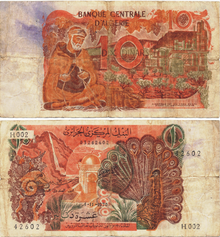Algerian dinar
This is the sighted version that was marked on February 10, 2021. There is 1 pending change that needs to be sighted.
The Algerian dinar (Arabic دينار جزائري dinar dschazairi, DMG dīnār ǧazāʾirī) is the currency of Algeria. One dinar is divided into 100 centimes. The ISO code is DZD.
The dinar is a currency denomination common throughout the Arab world, dating back to the Roman denarius.
All monetary matters are regulated by the Central Bank of Algeria.
The predecessor currency was the Algerian franc, which was legal tender in Algeria from 1848 to 1964. It had a fixed exchange rate of 1:1 to the French franc and was replaced by the Algerian dinar at a rate of 1:1 by the central bank in 1964.
The Central Bank issued the first series of coins in 1964, which included coins in denominations of 1, 2, 5, 10, 20 and 50 centimes and 1 dinar. At the same time, it issued the first banknote series with denominations of 5, 10, 50 and 100 dinars. This was followed by a banknote of 500 dinars in 1970 and one of 1000 dinars in 1992.
In 1992, Algeria initiated the issue of a second series of coins, which are still valid today: coins were issued in denominations of ¼, ½, 1, 2, 5, 10, 20, 50 and 100 dinars. Similarly, the fourth banknote series, which is still valid today, was issued: it includes banknotes with denominations of 100, 200, 500 and 1000 dinars. In 2011, banknotes with the value of 2000 dinars were issued. The ¼- and ½-dinar coins have since been withdrawn from circulation. Since 1 January 2015, 100- and 200-dinar notes are no longer recognised as means of payment; they have been replaced by the equivalent coins that were already in circulation.

Banknote of 10 dinars from the first series of 1964
Search within the encyclopedia